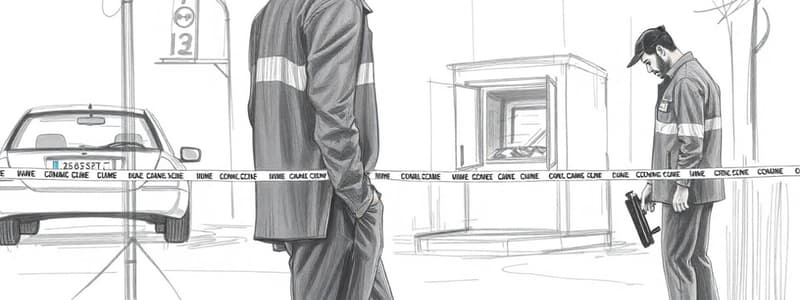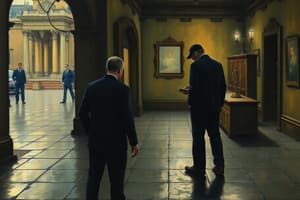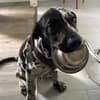Podcast
Questions and Answers
What type of crime scene sketch provides a bird’s-eye view or floor plan?
What type of crime scene sketch provides a bird’s-eye view or floor plan?
- Triangulated sketch
- Elevation sketch
- Overview sketch (correct)
- Exploded view sketch
Which of the following tools is NOT needed when creating a crime scene sketch?
Which of the following tools is NOT needed when creating a crime scene sketch?
- Camera (correct)
- Ruler
- Tape measure
- Compass
What is the purpose of triangulation in crime scene sketches?
What is the purpose of triangulation in crime scene sketches?
- To outline the perimeter of the scene
- To create a digital representation of the scene
- To determine distances between evidence and fixed points (correct)
- To measure the size of the crime scene
What should be labeled on a crime scene sketch for orientation?
What should be labeled on a crime scene sketch for orientation?
Which type of sketch combines both overview and elevation views?
Which type of sketch combines both overview and elevation views?
What is an essential characteristic of an overview sketch in crime scene documentation?
What is an essential characteristic of an overview sketch in crime scene documentation?
What should be included in a crime scene sketch to enhance clarity?
What should be included in a crime scene sketch to enhance clarity?
During the triangulation process in crime scene sketching, what is measured?
During the triangulation process in crime scene sketching, what is measured?
What is the purpose of using graph paper when creating a crime scene sketch?
What is the purpose of using graph paper when creating a crime scene sketch?
What should be done first when creating a crime scene sketch?
What should be done first when creating a crime scene sketch?
Which of the following types of sketches best represents vertical aspects of a crime scene?
Which of the following types of sketches best represents vertical aspects of a crime scene?
What is required for creating an exploded view sketch?
What is required for creating an exploded view sketch?
Which of these items is NOT considered essential equipment for sketching a crime scene?
Which of these items is NOT considered essential equipment for sketching a crime scene?
What aspect of the crime scene sketch aids in distance measurement besides the actual sketching?
What aspect of the crime scene sketch aids in distance measurement besides the actual sketching?
When sketching a crime scene, evidence should be represented using complex shapes.
When sketching a crime scene, evidence should be represented using complex shapes.
It is necessary to note the victim's name on a crime scene sketch only if the victim is known.
It is necessary to note the victim's name on a crime scene sketch only if the victim is known.
The true North indication on a crime scene sketch helps in orienting the scene accurately.
The true North indication on a crime scene sketch helps in orienting the scene accurately.
Triangulation of evidence requires measurements from movable points for accuracy.
Triangulation of evidence requires measurements from movable points for accuracy.
An exploded view sketch presents walls laid out flat while showing objects in their relative positions.
An exploded view sketch presents walls laid out flat while showing objects in their relative positions.
Triangulation refers to the process of measuring the distance between two fixed points to help locate evidence.
Triangulation refers to the process of measuring the distance between two fixed points to help locate evidence.
A rough sketch must always be drawn to scale before it can be used in formal documentation.
A rough sketch must always be drawn to scale before it can be used in formal documentation.
Graph paper is necessary for sketching to ensure that the scale of the sketch is accurate.
Graph paper is necessary for sketching to ensure that the scale of the sketch is accurate.
An elevation sketch is primarily used to depict overhead views of the crime scene.
An elevation sketch is primarily used to depict overhead views of the crime scene.
What is the most important prerequisite for photographing a crime scene?
What is the most important prerequisite for photographing a crime scene?
Which of the following best describes overview photographs taken at a crime scene?
Which of the following best describes overview photographs taken at a crime scene?
What must be true for photographs to be admissible as evidence in the Justice System?
What must be true for photographs to be admissible as evidence in the Justice System?
What area should be photographed in addition to the main crime scene?
What area should be photographed in addition to the main crime scene?
Which statement is true regarding points of entry and exit in crime scene photographs?
Which statement is true regarding points of entry and exit in crime scene photographs?
What is the primary significance of overview photographs taken at a crime scene?
What is the primary significance of overview photographs taken at a crime scene?
Which condition is essential for a crime scene to be photographed properly?
Which condition is essential for a crime scene to be photographed properly?
What should be included in the photographs taken at a crime scene?
What should be included in the photographs taken at a crime scene?
What must be true for photographs to maintain their credibility as evidence in court?
What must be true for photographs to maintain their credibility as evidence in court?
Which of the following is NOT a recommended practice when photographing a crime scene?
Which of the following is NOT a recommended practice when photographing a crime scene?
What must be documented if any manipulations of crime scene photographs occur?
What must be documented if any manipulations of crime scene photographs occur?
Which technique enhances the ability to visualize the relationship between evidence and the crime scene in forensic photography?
Which technique enhances the ability to visualize the relationship between evidence and the crime scene in forensic photography?
Which aspect is critical for ensuring photographs accurately reflect the unaltered crime scene?
Which aspect is critical for ensuring photographs accurately reflect the unaltered crime scene?
What is the main characteristic of digital photography that makes it preferred for crime scene documentation?
What is the main characteristic of digital photography that makes it preferred for crime scene documentation?
Match the following crime scene sketch types with their descriptions:
Match the following crime scene sketch types with their descriptions:
Match the following mapping techniques with their primary characteristics:
Match the following mapping techniques with their primary characteristics:
Match the following sketches with their intended uses:
Match the following sketches with their intended uses:
Match the following sketch types with their alternative names:
Match the following sketch types with their alternative names:
Match the following sketch types with their order of creation in crime scene investigation:
Match the following sketch types with their order of creation in crime scene investigation:
Each piece of evidence must be photographed at 4 different angles.
Each piece of evidence must be photographed at 4 different angles.
Oblique lighting is effective for highlighting details on flat surfaces without shadows.
Oblique lighting is effective for highlighting details on flat surfaces without shadows.
Photographs of evidence should be taken at 3 distances: close, mid-range, and long-range.
Photographs of evidence should be taken at 3 distances: close, mid-range, and long-range.
Using a light source positioned directly above an item is beneficial when photographing fingerprints.
Using a light source positioned directly above an item is beneficial when photographing fingerprints.
Photographs must include items of scale, such as rulers or coins, for accurate evidence representation.
Photographs must include items of scale, such as rulers or coins, for accurate evidence representation.
Digital photography is currently the least preferred method of crime scene documentation.
Digital photography is currently the least preferred method of crime scene documentation.
Overview photographs in crime scene documentation should only include the body and not the surrounding area.
Overview photographs in crime scene documentation should only include the body and not the surrounding area.
Photographs must reflect the true condition of the crime scene without alteration to be admissible in the Justice System.
Photographs must reflect the true condition of the crime scene without alteration to be admissible in the Justice System.
Objects at a crime scene should be moved immediately for better visual clarity before photographing.
Objects at a crime scene should be moved immediately for better visual clarity before photographing.
Points of entry and exit in crime scene photographs should be depicted clearly, including any marks of force.
Points of entry and exit in crime scene photographs should be depicted clearly, including any marks of force.
Flashcards
Crime scene sketch
Crime scene sketch
A diagram of a crime scene, showing layout, evidence, and measurements, crucial for investigation and record-keeping.
Crime scene sketch types
Crime scene sketch types
Different views of the crime scene including overview (floor plan), elevation (vertical surfaces like walls), and exploded view/cross-projection (combining overview and elevation).
Triangulation
Triangulation
A method for accurately measuring the distance of evidence to fixed points using measurements between the evidence and 2 fixed points.
Crime scene sketch materials
Crime scene sketch materials
Signup and view all the flashcards
Sketching procedure
Sketching procedure
Signup and view all the flashcards
Overview Sketch
Overview Sketch
Signup and view all the flashcards
Elevation Sketch
Elevation Sketch
Signup and view all the flashcards
Exploded View Sketch
Exploded View Sketch
Signup and view all the flashcards
Why use graph paper?
Why use graph paper?
Signup and view all the flashcards
Triangulation in Sketching
Triangulation in Sketching
Signup and view all the flashcards
What are the types of crime scene sketches?
What are the types of crime scene sketches?
Signup and view all the flashcards
What is an overview sketch?
What is an overview sketch?
Signup and view all the flashcards
Why is a crime scene sketch crucial?
Why is a crime scene sketch crucial?
Signup and view all the flashcards
What is triangulation?
What is triangulation?
Signup and view all the flashcards
What are the essential materials for creating a crime scene sketch?
What are the essential materials for creating a crime scene sketch?
Signup and view all the flashcards
What's the first step in sketching a crime scene?
What's the first step in sketching a crime scene?
Signup and view all the flashcards
How do you mark evidence on a sketch?
How do you mark evidence on a sketch?
Signup and view all the flashcards
What information should be included in a sketch label?
What information should be included in a sketch label?
Signup and view all the flashcards
What does triangulating evidence mean?
What does triangulating evidence mean?
Signup and view all the flashcards
Why is true north indicated on a sketch?
Why is true north indicated on a sketch?
Signup and view all the flashcards
Crime scene photography purpose
Crime scene photography purpose
Signup and view all the flashcards
Crime scene photography criteria
Crime scene photography criteria
Signup and view all the flashcards
Digital photography in forensics
Digital photography in forensics
Signup and view all the flashcards
Overview photographs
Overview photographs
Signup and view all the flashcards
Points of entry/exit photography
Points of entry/exit photography
Signup and view all the flashcards
Unaltered Crime Scene
Unaltered Crime Scene
Signup and view all the flashcards
Forensic Photography Purpose
Forensic Photography Purpose
Signup and view all the flashcards
Admissible Crime Scene Photos
Admissible Crime Scene Photos
Signup and view all the flashcards
Baseline Mapping
Baseline Mapping
Signup and view all the flashcards
Exploded Sketch
Exploded Sketch
Signup and view all the flashcards
Rough Sketch
Rough Sketch
Signup and view all the flashcards
Final Sketch
Final Sketch
Signup and view all the flashcards
Forensic Photography
Forensic Photography
Signup and view all the flashcards
Evidence Photography Angle
Evidence Photography Angle
Signup and view all the flashcards
Evidence Photography Distance
Evidence Photography Distance
Signup and view all the flashcards
What is a scale item?
What is a scale item?
Signup and view all the flashcards
Oblique Lighting
Oblique Lighting
Signup and view all the flashcards
Why use oblique lighting?
Why use oblique lighting?
Signup and view all the flashcards
Study Notes
Crime Scene Sketching
- A crime scene sketch is a crucial tool for documenting investigative data.
- Sketches are created after the scene has been photographed, or while photography is in progress.
- Sketches help record the overall layout of the scene.
Types of Crime Scene Sketches
- Overview (Bird's-eye-view/Floor plan): This is the most common type, showing a bird's-eye view or floor plan of the area.
- Elevation: Depicts a vertical plane, often used to show blood spatter patterns or other vertical evidence.
- Exploded view or cross-projection: A combination of overview and elevation. This type displays walls laid flat, and objects in their relative positions on those walls.
Creating a Crime Scene Sketch
- Measurements: Measurements should be taken without disturbing the crime scene.
- Graph paper: Use graph paper to ensure the sketch is drawn to scale.
- Rough sketches: A rough, non-scaled sketch can be created at the scene and later redrawn to scale, clearly labeled "Not to Scale".
- Equipment: Needed materials include graph paper, pencils, measuring devices (tape measures, survey wheels, rangefinders, total station), a compass, a ruler, and a clipboard.
- Evidence markers: Evidence should be noted using evidence markers (numbers or letters).
- Triangulation: Use triangulation to measure distances from fixed points to evidence like a body.
- Labeling: Clearly label the sketch with date, time, location, victim's name (if known), and true North.
- Legend/key: The sketch should include a clear legend/key to explain symbols used for different pieces of evidence.
Digital Representation
- Rough sketches can be converted into a digital representation for use in crime scene reports.
Where to Start Sketching the Scene
- Step 1: Outline the perimeter of the crime scene area on graph paper, including windows and doors.
- Step 2: Measure the perimeter of the room or area and label dimensions on the sketch.
- Step 3: Add furniture and locations of evidence.
- Step 4: Label the sketch with date, time, location, and the victim's name.
- Step 5: "Triangulate" evidence by measuring from fixed points to specific pieces of evidence.
- Step 6: Indicate true North on the sketch.
Assignment Considerations
- Students often receive a "reference card", providing samples of evidence used to prepare their sketches.
- Some crime scene exercises utilize playing cards to represent the evidence.
- Students are responsible for locating the specific evidence and placing them appropriately on the sketch they're creating.
Studying That Suits You
Use AI to generate personalized quizzes and flashcards to suit your learning preferences.





